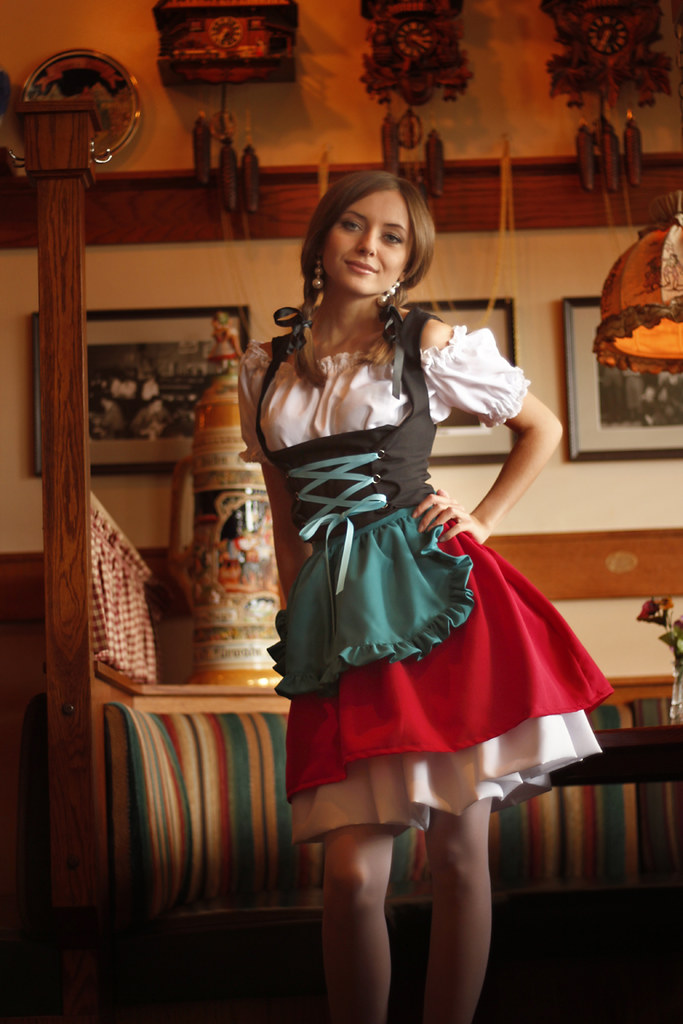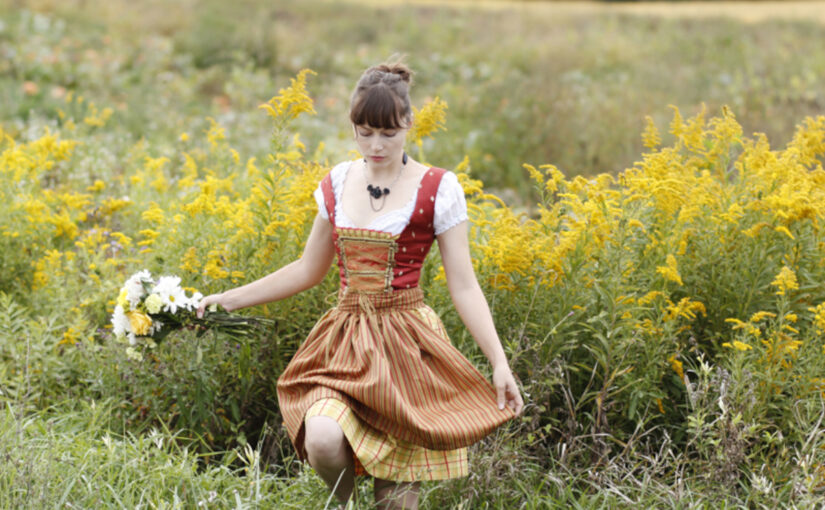Imagine stepping into a bustling Oktoberfest tent in Munich. The air hums with laughter and the clink of steins, while women swirl by in vibrant dresses that catch the light. Their skirts flare with every step, aprons tied neatly at the waist, and bodices hugging curves with elegant precision. This is the dirndl, a garment that embodies the spirit of the Alps. Far more than just clothing, it tells stories of rural resilience, cultural pride, and modern flair. From humble farm origins to global fashion statements, the dirndl has woven itself into the fabric of Bavarian and Austrian identity. Let’s explore its rich history, distinctive features, and enduring appeal.
Roots in the Alps: The Dirndl’s Humble Beginnings
The dirndl’s story starts in the rugged Alpine regions of Bavaria and Austria, where it emerged as practical attire for rural women. In the 16th to 18th centuries, peasant life demanded sturdy clothing that could withstand daily labors like tending fields, milking cows, and managing households. Women in these mountainous areas wore simple dresses made from durable fabrics such as linen or wool, designed for ease of movement and protection against the elements. The name “dirndl” itself derives from “Diernen,” a 19th-century term for maids working on farms in Bavaria and Austria. It wasn’t a fashion statement back then. Instead, it served as a functional uniform, often paired with an apron crafted from basic materials like bed linen to shield the skirt from dirt and wear.
As the 19th century unfolded, the dirndl began to evolve beyond its workaday roots. Romantic nationalism swept through Europe, sparking interest in folk traditions and local customs. In response to the dominance of French fashion, movements like the Trachtenvereine promoted traditional attire to preserve regional identities. Royalty and the upper classes took notice, adopting simplified versions for leisure in resort towns. This shift blended rustic elements with more refined silhouettes, using finer fabrics and fitted designs. The dirndl transitioned from a symbol of the working class to a marker of cultural heritage, reflecting social status and Alpine pride.
A pivotal moment came with the contributions of Jewish clothing merchants Julius and Moritz Wallach. These brothers, originally from Bielefeld, moved to Munich and founded a tracht business in 1900. They specialized in folk costumes, drawing inspiration from rural styles. In 1910, for the centennial of Oktoberfest, they outfitted the entire regional heritage parade, introducing rurally inspired designs that caught the eye of urban elites. Julius earned the title of Purveyor to the Royal Court, and their innovative textiles, dyed and woven to unique specifications, created a signature “Wallach look”. By 1930, their costumes for the popular operetta “Im weißen Rössl” propelled the dirndl into widespread fashion, adapting it for summer and winter with puffed sleeves, laced bodices, and warm flannels in colors like loden green. The Wallachs didn’t just popularize the dirndl; they reinvented it, bridging rural tradition with metropolitan appeal.
Anatomy of a Dirndl: Features and Hidden Meanings
At its core, the dirndl is a harmonious ensemble of four key elements: the bodice, blouse, skirt, and apron. Each piece contributes to its feminine silhouette and carries layers of symbolism. The bodice, or Mieder, fits snugly to accentuate the waist and bust, often featuring embroidery, hooks, or chains for decoration. It’s typically made from cotton, velvet, or silk, with necklines ranging from modest squares to daring scoops. Underneath sits the blouse, usually white with puffed sleeves that add a romantic puff at the shoulders, enhancing the wearer’s figure while allowing freedom of movement.
The skirt flows from a high waist, gathered fully to create volume, and falls to knee or ankle length depending on the occasion. Fabrics might include colorful prints with floral or vine motifs, evoking the Alpine meadows. But the apron ties it all together, literally and figuratively. Worn over the skirt, it’s both practical and expressive, often in contrasting colors or patterns.
Symbolism runs deep, especially in the apron’s bow. Tied on the left, it signals the wearer is single and open to flirtation. A right-side knot indicates she’s taken, perhaps engaged or married. When centered at the back, it might denote a widow or, in festive settings like Oktoberfest, a waitress navigating crowded tents with efficiency. Colors add another dimension: red conveys passion, confidence, and energy, perfect for drawing attention in a sea of revelers. Blue represents loyalty and harmony, paired with white aprons for a sense of purity. These details aren’t mere whims; they whisper stories of personal status and cultural codes, making every dirndl a subtle narrative.

From Farm Fields to Folk Festivals: Everyday and Celebratory Roles
In its early days, the dirndl was inseparable from rural life. Women donned it for grueling tasks, from harvesting crops in sun-drenched valleys to mucking stables in chilly mountain air. The design prioritized durability: wide skirts allowed strides across uneven terrain, while aprons protected against spills and stains. It mirrored social hierarchies too, with variations in fabric quality or embroidery denoting regional origins or family standing. In Bavarian villages, a dirndl might be an heirloom, passed down through generations and worn to church or local markets, blending utility with quiet pride.
Over time, this everyday garment blossomed into festive wear. The 19th-century folk revival elevated it for holidays and gatherings, but Oktoberfest truly cemented its celebratory status. What began as a royal wedding celebration in 1810 grew into the world’s largest folk festival, where dirndls became synonymous with merriment. Picture a mountain wedding in the Austrian Alps: brides and guests in heirloom dirndls, skirts rustling against wildflower-strewn paths, as fiddles play and feasts unfold under starry skies. At festivals like these, the dirndl fosters community, linking participants to shared traditions.
Modern Twists: Reimagining Tradition for Today
The dirndl hasn’t stayed frozen in time. Contemporary designers infuse it with fresh energy, adapting it for diverse wearers. Fashion houses experiment with velvet textures, monochrome palettes in shades like apricot, and integrated or detachable cap sleeves for versatility. A 2025 trend highlights winged-sleeve dirndls, wearable in four ways: sleeveless for warm days, with romantic caps for a vintage touch, or layered for elegance. These updates appeal to younger generations, who might pair a knee-length version with modern accessories for urban outings.
Tourists embrace it as a fun immersion, donning affordable versions at Oktoberfest to blend into the crowd. Locals, meanwhile, cherish authentic pieces for authenticity, often customizing with heirloom jewelry. Younger Austrians and Bavarians remix it boldly, shortening skirts or adding bold prints, turning heritage into personal expression. Even high-fashion runways feature dirndl-inspired looks, proving its global adaptability while honoring roots.
Embodying Heritage: The Dirndl’s Cultural Heart
For Bavarians and Austrians, the dirndl represents more than fabric; it’s a badge of identity. It evokes Alpine resilience, communal bonds, and a connection to the land. In a fast-paced world, wearing one reaffirms heritage, especially amid tourism booms that spotlight festivals like Oktoberfest. It boosts local economies too, with artisans crafting pieces that sustain traditions. Yet, it navigates complexities, from historical ties to nationalism in the 1930s and 1940s, to today’s inclusive adaptations that celebrate femininity and diversity. Ultimately, the dirndl stands as a living emblem of cultural pride, inviting all to partake in its warmth.
Why not slip into a dirndl yourself? Next time you visit Bavaria or Austria for a festival or Alpine hike, embrace the tradition. It’s a delightful way to connect with the region’s vibrant soul.
References & Further Resources:
- The Fashion History of the Dirndl – The Pink Lookbook: https://thepinklookbook.com/the-fashion-history-of-the-dirndl/
- Dear Dirndl: Unraveling the Thread of Tradition – Georgetown Voice: https://georgetownvoice.com/2024/09/30/dear-dirndl-unraveling-the-thread-of-tradition/
- Dirndl: Exploring Identity and Tradition in Fashion – Unicus Olympiads: https://www.unicusolympiads.com/concepts/how-do-clothes-like-dirndl-show-identity-and-tradition
- Why the Dirndl is So Much More than a Dress for Oktoberfest – Dismantle Magazine: https://dismantlemag.com/2019/09/23/dirndl-dress-history-oktoberfest/
- A 101 Guide to Dirndls: Choosing Traditional Bavarian Attire – Kelliar Dirndl: https://kelliar-dirndl.com/blogs/knowledge-hub/a-101-guide-to-dirndls-choosing-traditional-bavarian-attire
Header image by alessandranova.
